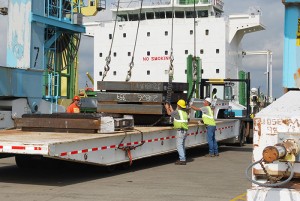Port of steel: Port of Vancouver USA assets, capabilities bring continued impressive growth in steel

Longshore workers at the Port of Vancouver USA transfer steel slabs from ship to truck
In 2013, the Port of Vancouver USA imported 99,225 metric tons of steel, mostly in the form of coil and pipe. One short year later, we were the fastest-growing West Coast port for steel and number two in overall steel imports.
How did we get there? Location, capabilities and value-added customer service.
The Port of Vancouver is positioned in the center of a regional metals cluster, with excellent access to the Columbia River, Class I rail lines and interstate highways. Our unique capabilities – including two mobile harbor cranes, ample laydown space and an efficient labor force – make us one of the most effectual ports on the West Coast.
And our talented staff members are logistics experts, skilled at finding the most cost-effective and efficient ways to move cargo. Those services don’t end when cargo reaches Vancouver; we’re also involved in the inland logistics of efficiently moving products by truck or rail to their final destinations.
So it’s only natural that companies looking to move steel efficiently would look to the Port of Vancouver to meet their needs. And in 2014, that’s just what we saw. By the end of the year, the port recorded 590,170 metric tons of imported steel, a 495 percent increase over 2013.
In 2015, steel imports grew an impressive 30.6 percent over the previous year, bringing numbers in at 770,627 metric tons.
We expect to continue growing in steel imports as we continue honing our advantages and means of handling steel. Among those advantages is ample storage – we have more undercover storage than any other U.S. Pacific Northwest port, and plenty of outside storage, too.
We’re proud of our growth in steel and of our ability to meet the challenges and needs of our customers. With the Port of Vancouver USA – Port of Possibility – the sky is the limit.
